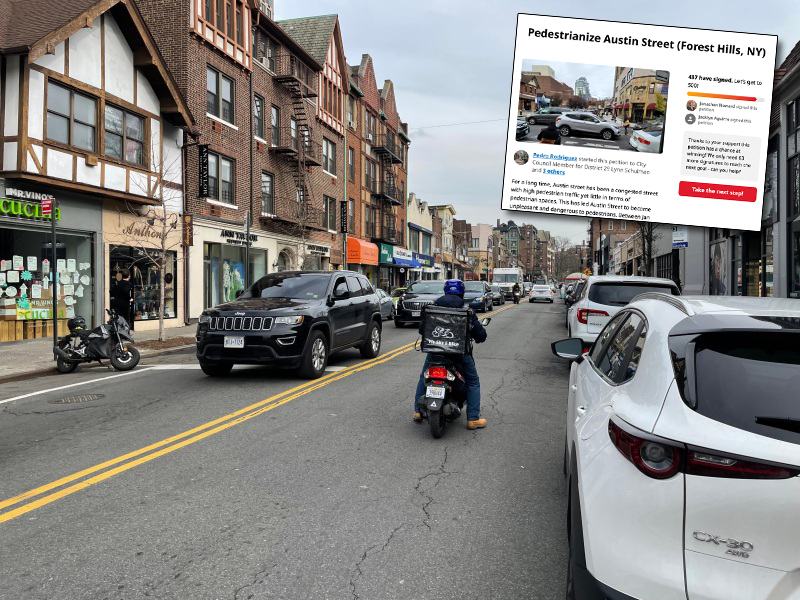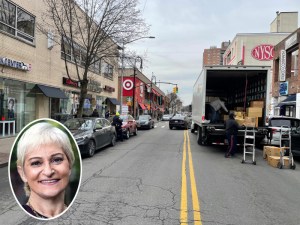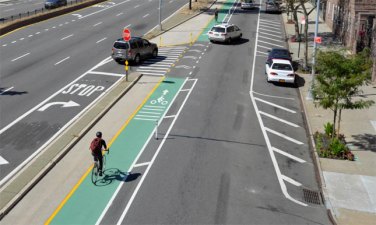Queens Panel Wants a ‘Pedestrian-First’ Austin Street — And a Possible Car Ban

Austin Street in Forest Hills should be transformed into a pedestrian paradise instead of the car-choked, will-sapping roadway it is today, a growing number of Queens residents are saying.
The Transportation Committee on Queens Community Board 6 unanimously endorsed an effort to get the city Department of Transportation to make the crowded commercial stretch into a more welcoming space for pedestrians.
At present Austin Street — a popular shopping and eating destination just a stone’s throw from Forest Hills Tennis Stadium — is a two-way street serving local businesses, a design that results in packed sidewalks and lots double parking, according to locals.
The strip sits right next to an LIRR stop and the E, F, M and R trains, making it a magnet for visitors from outside the neighborhood. The street sees heavy pedestrian flow especially when the nearby stadium hosts concerts in the summer (maybe you were lucky enough to snag boygenius tickets?)
“This street is the victim of its own success,” said Daniel Solow, a Forest Hills resident who lives in a nearby apartment building. “Because it’s such a popular street, you notice a lot of commercial activity, but also a lot of cars, a lot of double parking a lot of honking.”
Pedestrians and cyclists bear the brunt of the traffic violence thanks to the car-first design. There were 356 reported crashes that caused 80 injuries on Austin between Yellowstone Boulevard and Ascan Avenue from January 2018 to November 2022, according to city records. The majority of those injuries, 48, were to pedestrians and cyclists.
In a resolution passed Feb. 23, the committee asked the city to study a “pedestrian-first redesign” the largely commercial strip of Austin Street between Yellowstone and Ascan. The committee’s suggestions included:
- Widening the sidewalks
- Reducing pedestrian hazards by eliminating car congestion and honking
- Creating outdoor seating areas
- Allowing more space to be used by the Open Restaurant program
- Creating more safe crossings for pedestrians
- Effects of a one-way conversion (westbound) of Austin Street on pedestrian safety
- The possibility of pedestrianizing segments of Austin Street between Yellowstone Boulevard and Ascan Avenue.
“The sidewalks on Austin Street are narrow and crowded, making it difficult for people who require more space to move around, such as people on wheelchairs and mobility scooters, as well as people with walkers and strollers,” the committee wrote in its resolution.
The endorsement of greater pedestrianization is the latest in a years-long saga to improve conditions on the strip, dating back to at least 2018. That years, the city added loading zones to the block amidst complaints from business owners and residents that truck drivers making deliveries constantly double parked on the street that has only one eastbound and one westbound lane.
In 2020, the city included restaurants on Austin Street as part of the initial outdoor dining program, and even turned 70th Road between Austin Street and Queens Boulevard into a car-free, outdoor dining plaza, but in 2021 area business interests quashed efforts to bring an open street to Austin Street itself.
A possible business backlash is on the minds of people who want to see Austin Street cater to more than just car and truck drivers, though pedestrianization proponents suggest there’s more for local businesses to gain than to lose from pedestrian-focused street improvements.
“There’s businesses here that are new and exciting, but also business that are closing,” Solow said, pointing to a local cheese shop and local bar that had recently shuttered.
“People [say], ‘This is going to destroy businesses’ — but business is already going down. So why aren’t we talking about ways to make this a little bit more resilient? I’ve been to the parts of the city and I’ve been to Europe, and I’ve seen examples of streets that are fully pedestrianized and you can’t even see the ground because here’s so much foot traffic. I don’t see why we can’t have that here.”
But the community board’s backing is a boon for Pedro Rodriguez, a Forest Hills resident who’s been petitioning for the people-first changes to the block since last September.
“I am so happy this is finally getting recognition,” said Rodriguez. “Everyone in the community knows that Austin Street is a mess that needs fixing ASAP.”
Even with the previous opposition sinking open streets on the Forest Hills stretch, Rodriguez said he’s undeterred, and has already gotten 10 businesses on the block to sign on to aims of the petition and resolution. With that momentum, he asked the DOT to quickly move on the safety upgrades.
“We need this study and action as soon as possible. Austin Street is a hazard, we can’t wait years for a possible study while people are getting hurt, businesses are suffering and more and more transit users decide to switch to cars because the Q23 is impossible to use. We know that you know what works, as you’ve done this all around the city, so do it,” Rodriguez said.
Council Member, Lynn Schulman (D-Forest Hills), did not return a request for comment. For its part, the city said that it’s looking forward to figuring out what to do about Austin Street.
“We appreciate the board’s support of DOT’s Vision Zero efforts and look forward to future discussions about safety and public space improvements along this stretch of Austin Street,” said DOT spokesperson Vin Barone.

